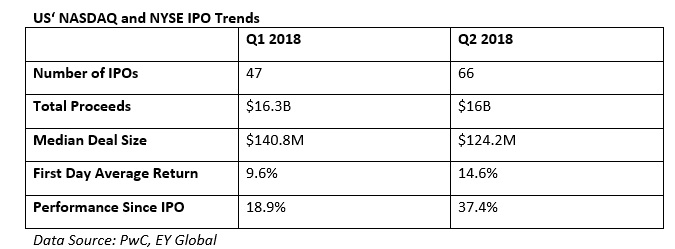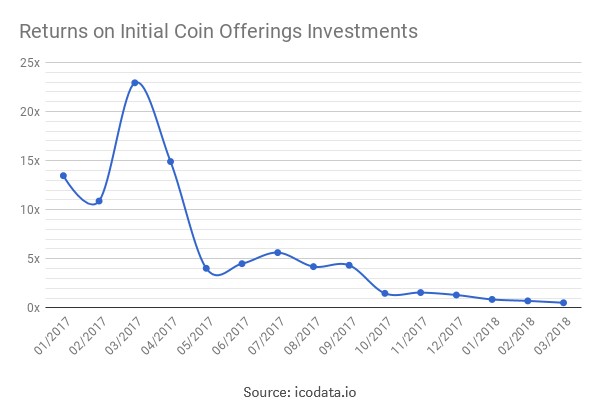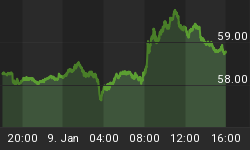Cryptocurrency capital markets might be less than three years old, but they are already challenging the supremacy of traditional investment banks as a way for startups to raise much-needed funds for growth and expansion.
The initial coin offering (ICO) market is defined as capital raised by startups on open blockchains via token sales. During Q2 2018, the ICO market was able to raise approximately $7.2 billion, good for 45 percent and 31 percent of the traditional IPO and venture capital markets, respectively. That was an improvement compared to 40 percent and 30 percent of the markets during Q1 2018.
Benefits To Issuers
From that data, it’s quite clear that ICOs have become a force to reckon with in the capital markets.
There are a couple of good reasons why more startups are opting for ICOs instead of spending months pitching VCs. But all in all, it boils down to this—it’s easier and cheaper to finance a startup via an ICO compared to IPOs or venture capital funding.
That’s the case because the ICO market demands zero preferences or covenants from the issuers compared to IPOs and VCs which dilute the owners’ stake. The closest thing we have to ICOs in traditional capital markets is known as “secure financing” or “securitization”, since both are non-dilutive and investors can trade or redeem the underlying assets for cash.
The second big reason is that the process of an ICO is generally smoother and faster compared to the other two methods. Friction costs are lower since there are no underwriters, transfer agents, trustees, custodians, exchanges, central securities depositories or clearinghouses involved in ICOs. Cumulatively, these friction costs can be quite high in aggregate.
Further, an average IPO campaign takes 4-6 months to reach conclusion. In contrast, ICOs generally take much shorter timeframes. Once a whitepaper has been drafted and a smart contract finalized, ICO service providers can begin the sale immediately. Most startups are able to reach their targeted financial value in a month and sometimes much less when the hype factor is high enough.
Related: Is This What Has Kept Gold Prices Low?
But ICOs are not just being favored by cash-strapped startups. Private companies that want to raise capital while maintaining their autonomy are now opting for ICOs.
We have already seen this with Telegram, whose ICO was able to raise nearly $2 billion. Through the ICOs, Telegram was able to raise IPO-sized, non-dilutive capital with few strings attached. ICOs are also an appealing alternative to distressed financing. Good case in point is Eastman Kodak whose joint ICO with WENN Digital helped infuse a significant amount of money to the company’s coffers at a lower risk while giving the company’s shares a nice boost to boot.
Benefits for Investors
While most ICO benefits appear to skew towards company owners, there are some important benefits for investors as well.
One of the most important is ease of access. Retail investors usually get the short end of the stick when it comes to IPOs, with investment funds, mutual funds and other institutional investors getting the lion’s share of ownership. In other words, you are basically locked out if you belong to the mile-high club.
With a few exceptions, ICO ownership tends to be much more democratic. With a certain amount of bitcoin or ether, you have as good a chance as anyone to buy yourself some tokens. Of course, there are some owners who scam investors by retaining a disproportionately large amount of tokens though they tend to be few and far between.
The short time that it takes to complete an ICO is no doubt a bonus for investors looking to quickly flip their tokens for some quick profit. In fact, majority of ICO investors are speculators and not the HODL type.
And that brings us to the biggest question of them all: do ICOs yield better returns than IPOs?
That would have seemed like a no-brainer a few months ago. But with the crypto market receiving a shellacking, it requires digging deeper.
According to data from IPO services firm EY Global, U.S. IPOs realized one-day returns of 9.6 percent and 14.6 percent during Q1 2018 and Q2 2019, respectively. The returns swelled to 18.9 percent and 37.4 percent for each quarter since the IPO.

(Click to enlarge)
So how do ICOs stack up?
According to a May report by the Boston College Carroll School of Management, 4,000 ICOs under study returned 82 percent. Average token sale price from the first day of the IPO were 179 percent higher than the offer price with an average holding period of just 16 days.
Related: Bitmain’s IPO Is Not Looking So Hot Right Now
It’s, however, important to take the study with a grain of salt because it looks at ICOs from January 2017 when the market was less than a tenth its current size even after the huge correction and returns were abnormally high.
This chart by ArgonGroup shows how ICO returns have fallen off a cliff since early 2017.

(Click to enlarge)
Source: Medium
From the chart, it appears like ICO returns in March were around x.4 to x.5, which implies a still very decent 40-50 percent gain--much higher than what IPOs are yielding. It’s however important for investors to consider the risk/reward profile of ICOs considering the constant warnings about scams.
This July report says nearly 80 percent of ICOs are scams, while this other one says that more than half fail within the first four months.
The high returns by ICOs are consistent with high compensation for risk for investing in unproven products. Whether they are high enough to fully compensate for that risk is for investors to judge.
By Alex Kimani for Safehaven.com
More Top Reads From Safehaven.com
















